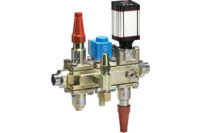PROPANE
Researchers at the University of Padova in Italy conducted experiments with a semi-hermetic reciprocating compressor working with propane. Tests were performed with and without an internal heat exchanger (IHX) between the suction and liquid line.“In test runs without the IHX, suction superheat was varied from 4K to 14K, while in the test runs with the IHX suction superheat ranged from 20K up to 35K,” the paper said. “The additional superheating achieved inside the compressor shell because of motor cooling and mechanical losses is estimated to be around 10 to 15K.
“The use of the IHX is shown to increase the compression efficiency … the positive influence of the superheating on the global efficiency is shown to be mainly due to an improvement of the volumetric efficiency.”
Regarding the refrigerant, it was noted, “Such experimental results can be explained by means of the high solubility of propane with the mineral oil used as the lubricant. The solubility is shown to strongly decrease by increasing the superheat. As a consequence, the viscosity of the oil-refrigerant mixture strongly increases with superheating until reaching a maximum at around 30-40K superheating. When the IHX is not used, the volumetric efficiency is expected to decrease because of the pool sealing property of the lubricant.
“The possibility of condensation inside the cylinder has also been considered. A rough qualitative estimation of this phenomenon is here proposed showing that it is expected to be more relevant with propane as compared to R-22 and that also in this case, the suction superheat would have a positive influence on the volumetric efficiency.”

Attendees head to another round of seminars during concurrent conferences at Purdue University that covered compressor engineering, refrigeration and air conditioning, and high performance buildings.
ISOBUTANE
Researchers from the Graz (Austria) University of Technology presented a paper dealing with different equations for simulating how a hermetic reciprocating compressor might perform. The aspect of most interest to HVACR contractors was the refrigerant isobutene in all the simulations.The highly technical paper dealt with “ideal gas” and “real gas” modeling and “two equations of state compared to study the influence on the compressor performance.” Of interest was the finding that “adequate boundary conditions for the walls of the cylinder and the suction and discharge line is much more important than the usage of an improved gas model.”
FUEL CELLS
A team of scientists from the University of Technology of Belfort-Montbeliard in France, in conjunction with the Colorado School of Mines in Golden, Colo., presented a paper on a three-lobe compressor for a fuel cell system.“The manifold inlet, a control volume representing the fuel cell cathode, and an electrical butterfly valve at the cathode outlet allows the control of the pressure. The dynamic of each component will be given to design the proper controller of the fuel cell air supply system. The quantities to be controlled are the air mass flow depending on the load demand and the cathode pressure that has to remain constant. The actuators used are a variable-speed, three-lobe compressor at the cathode inlet which mainly controls the air mass flow, and an electric-driven butterfly valve at the cathode outlet allowing the pressure control,” said the report.
The purpose was to look at the air supply system impact on overall efficiency, noise emission, and cost of the fuel cell system. The research said, “The air supply system must provide the total mass flow necessary to power the module at the pressure level required.”
WATER-COOLED
A paper from Danfoss Turbocor Compressors did a season energy efficiency analysis of a water-cooled chiller with multiple oil-free, high speed, direct-drive centrifugal compressors.One aspect of the report noted, “The absence of oil in the system will result in a simple piping arrangement due to elimination of components associated with oil management such as oil separator, oil pumps, oil heaters, and oil coolers. Also, as a consequence of oil elimination, better heat transfer in the evaporator or condenser vessels will improve, resulting in smaller approach temperatures. The pressure ratio that the compressor has to deliver reduces as a result of the smaller approach temperatures thus improving overall system efficiency.”
The document went into a comparison with what it described as “typical water-cooled screw chillers” and maintained that a water-cooled, oil-free, direct drive centrifugal can produce energy savings and reduce CO2 emissions.
Publication date:08/30/2010


